Asiatic lily: varieties, planting and care
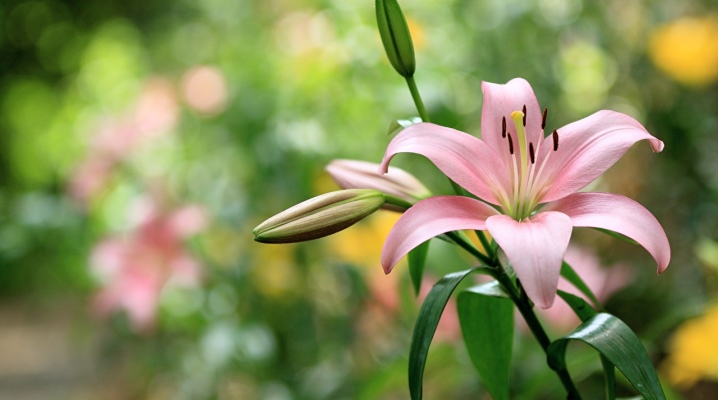
Lilies are considered the most beautiful garden flowers, so they are often used in the landscape design of many summer cottages. Especially popular with gardeners are Asian lilies, which are easily grown in any climatic zone and decorate flower beds with their bright inflorescences in an original way. To grow such a flower on your own, it is important to take into account the varietal characteristics of the plant and provide it with proper care.
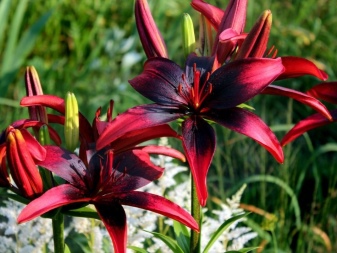
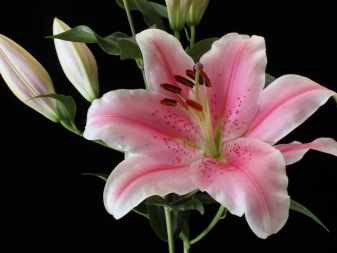
Description
The Asiatic lily is a hybrid obtained by crossing various types of ornamental plants that are resistant to low humidity, sudden changes in temperature and severe frosts. Therefore, it is perfect for landing on the territory of Russia. Asiatic lilies are distinguished by a varied color of flowers, which sometimes consists of several tones, but most often milky and bright fiery shades prevail in color. This feature makes the buds look larger and more attractive.
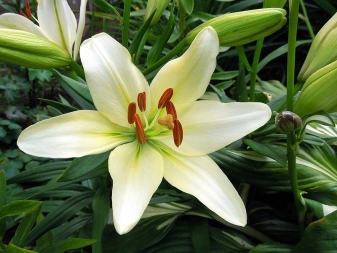
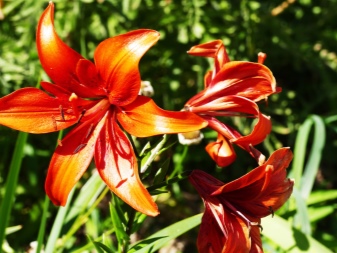
Up to 30 beautiful flowers are usually located on one stem of a plant, the structure of which can be either double or simple. They fill the garden with a rich sweet aroma. The flowering period for plants begins in the first half of July and lasts until the end of August. All lilies of this type are characterized by resistance to cold and unpretentious care.
They tolerate frosts down to -40 ° C.
Asian varieties can have different heights, the minimum values of which are 50 cm, the maximum - 1.5 m. The leaves of the plant are alternate, medium-sized, painted in a rich green color. The root system consists of contractile and basal roots that grow from the bottom of the bulb. Additionally, lilies also have supra-luminal roots, which help them to hold the stem.

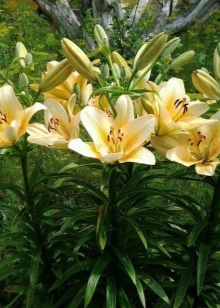
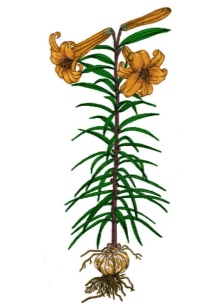
Hybrids and varieties
Depending on the color palette and the shape of the inflorescences, Asiatic lilies are divided into several groups, each of which has its own characteristics and requirements for growing. Let's list the most common ones.
- "Brashmark". This hybrid is distinguished by the original color of the inflorescences, in addition, on each petal you can see strokes in the form of strokes. These lilies can be colored red, brown, beige, cream and lemon.
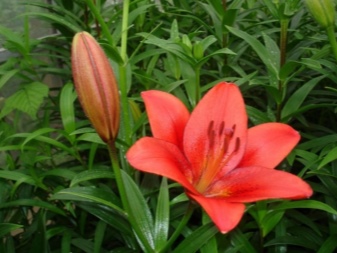
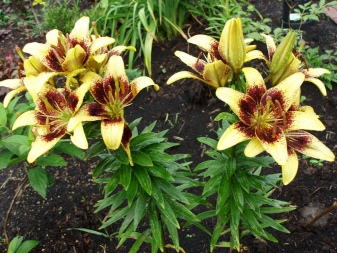
- Malvina. The flower shape of these varieties is half-open, turbid. The main feature is that the flowers in the inflorescences are sent in different directions. Their color is bright yellow, with red spots on each petal. The bushes are medium-sized and reach a height of 70 to 80 cm. Unlike other varieties, "Malvina" has a weak aroma.
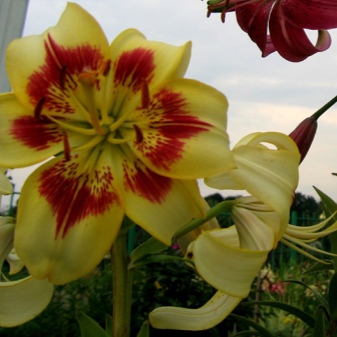
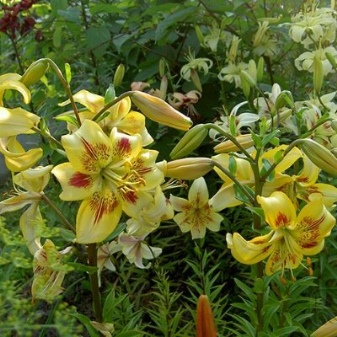
- Annemaris Dream. It is a herbaceous perennial plant with straight stems and dense foliage of green or dark purple color. The height of the bushes can be different depending on the conditions of planting and growth, it usually ranges from 30 to 250 cm. The flowers of lilies are solitary, they are collected in umbrella-shaped or pyramidal inflorescences. The color can be yellow, white, pink, lilac, orange flowers are also found.
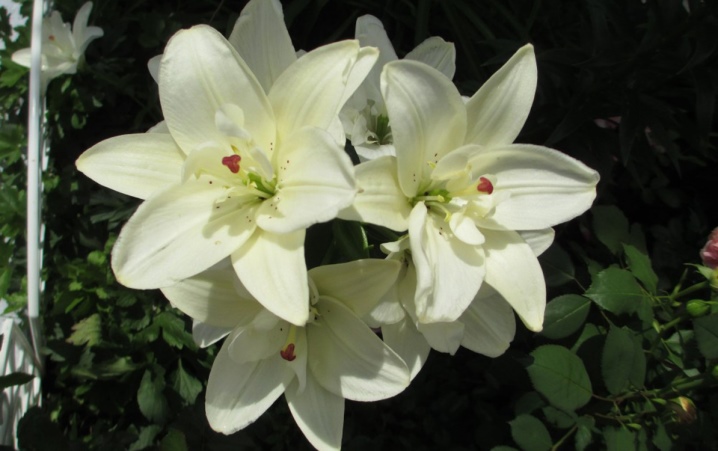
- "Tango". This hybrid is characterized by rich yellow flowers, which do not exceed 17 cm in diameter. The center of the petals is colored dark brown, gradually turning into brown specks. Flowers outwardly resemble large stars, they open wide and bloom upward.The stems of the plant are green, straight, covered with dense foliage. The height of the bushes is usually up to 110 cm.

- Lollipop. These are beautiful plants with two-color flowers. The middle is represented by a snow-white shade with small brown blotches, and the tips are crimson-pink. The flower petals are small, 4 cm wide and 9 cm long.
Such lilies can grow up to 90 cm in height and begin to bloom 70 days after germination.
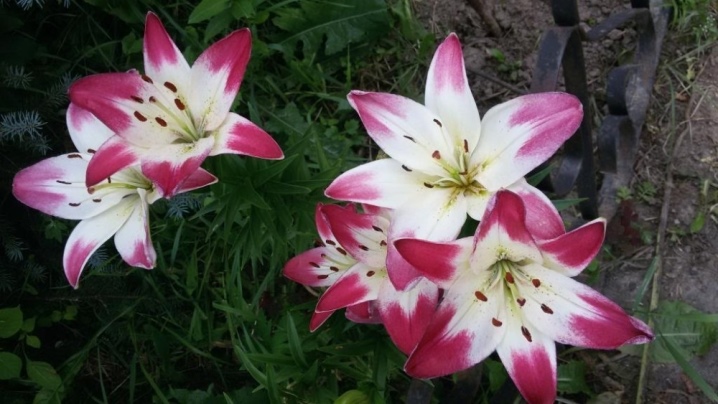
- "Detroit". The leaves of this variety are petiolate or sessile, their length does not exceed 20 cm. They are usually arranged in a regular order, much less often whorled. Inflorescences are collected from 2-4 flowers. As for the color, such Asiatic lilies can be either white, yellow, pink, or orange or red. The plant prefers to grow in shaded areas.

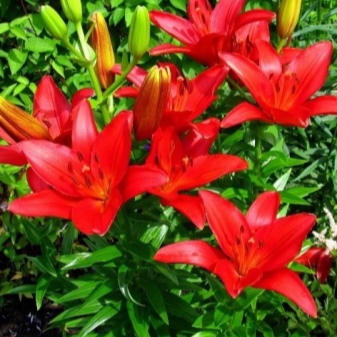
- Brunello. This is a short lily of snow-white, orange, yellow or lilac color. In some plants, air bulbs (bulbs) can develop on the stems, which can be used for reproduction. Flowers are single. This variety is suitable for both group planting and for decorating flower beds, mixborders.

- Forever Susan. This variety is distinguished by unpretentiousness in care and resistance to frost. Since the height of the bushes reaches no more than 70 cm, they can be grown in pots. This indoor lily will complement any interior with its bright colors in an original way. The flowers are painted in two colors: the middle is orange, and the tips are plum black.
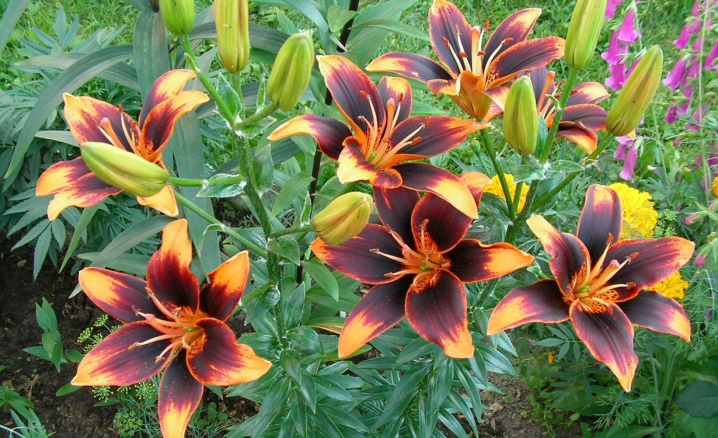
- Golden Stone. The main feature of this variety is the presence of a huge number of dark specks in the center of the flower. During flowering, the lily is unusually beautifully used in the landscape design of the garden plot, creating an original mixborder with its color palette. Its flowers have a faint pleasant aroma. It grows in length up to 120 cm, there are also specimens of a plant 150 cm high.
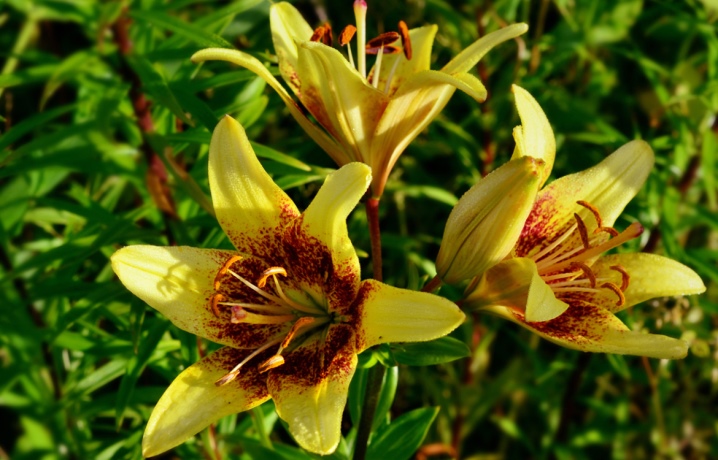
In addition to the above hybrids and varieties, are very popular with gardeners and lilies "Spring Pink", "Apeldoorn", "Easy Samba", "Mystery Dream", "Mapira", "Prominens"... All these plants are easy to grow and are able to delight with their flowering from early June to late August.

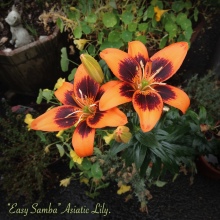
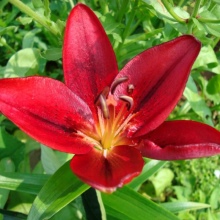
How to plant?
Planting of Asiatic lilies in open ground is carried out only in either the spring or autumn months. It is necessary to plant plants in pre-prepared soil. To do this, first choose a suitable seat, which should be spacious and light. Areas where the soil has a neutral acidity level are well suited for planting lilies. After that, good quality bulbs are selected - they must be dense, healthy and not have spots on the surface.
To protect the bulbs from pests, it is recommended to soak them in Karbofos solution for several hours before planting.


The disembarkation process itself is quite simple.
- First of all, you should carefully level the ground on the site, then dig a trench up to 40 cm deep.A little sand is poured at the bottom of the resulting hole, and an elevation is formed into which the side of the bulb is laid out.
- Next, sand is poured over the planted bulbs again, and everything is covered with a layer of fertile soil, into which compost and humus are added in advance.
- Planting ends with abundant moisture and mulching of the soil. After that, it is important to control the germination process of the bulbs by timely watering the area where they are planted.


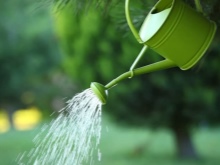
How to take care of it properly?
Unlike other types of garden flowers, Asiatic lilies are undemanding to care for. The only thing, when growing them at home, you should remember that the plant can be in one place for no more than 3-4 years. If this is not done, then the buds will become more and more every year, but they will not be able to open.
Plant care also includes fertilization. The first time feeding is carried out when the lily reaches a height of 10 cm. Potassium nitrate is well suited as a fertilizer, with which the flower is fed once every 2 weeks.

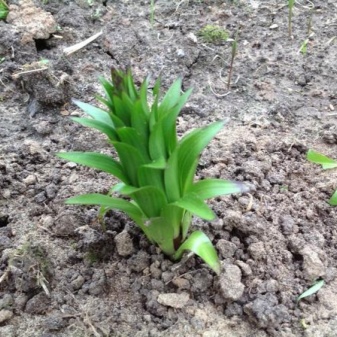
Feeding lilies is stopped during their flowering period, otherwise the plant will throw off all the buds. Fertilization is completed at the end of August, when the Asiatic lily has faded and is preparing for wintering. All wilting inflorescences must be removed immediately, otherwise seed pods will begin to form from them, which will affect the growth of the plant.
We must also not forget about mulching, which is usually performed immediately after planting the bulbs, forming a small layer 5 cm thick from pine bark, sawdust or tree foliage.
Asiatic lilies differ from other species in that they do not require bush formation and pruning. Therefore, it is enough for gardeners at the end of October to simply remove the wilted part of the plant placed above the soil surface. In this case, it is necessary to check that the bulbs do not form "children", otherwise they will lose the nutrients accumulated over the winter and die.
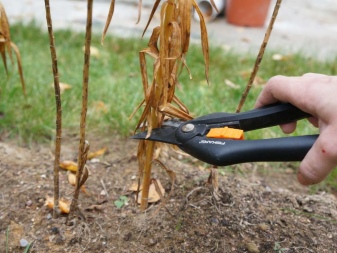

In Asian lilies, as they grow, daughter bulbs are formed underground, with a significant number of them, the plant becomes cramped in one place. It is easy to notice: the lily will begin to form weak shoots, the flowers will become small.
If the plant is not transplanted, it may lose its decorative qualities.
Usually, Asian lilies perfectly tolerate winter without the construction of special shelters... A thick layer of snow is sufficient for plants. If the winter has little snow, then the flower bed must be additionally insulated with peat, sawdust and spruce branches. In the spring, with the onset of warmth, all this is removed, and young shoots of lilies will quickly hatch.

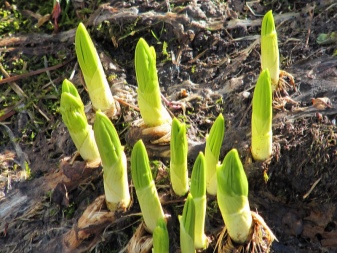
Reproduction methods
Asiatic lilies reproduce with daughter bulbs. This procedure is usually carried out during plant transplantation. They are carefully separated from the mother plant and placed in a special container. The distance between the bulbs during planting in the ground should not be less than 7 cm. Daughter bulbs cannot be stored for a long time, therefore it is advisable to immediately transplant them into open ground, giving preference to areas with moderate acidity.
Some gardeners propagate Asiatic lilies and seeds, but the probability of sprouting in this case is no more than 70%. In addition, with this method of reproduction, plants cannot retain their decorative color. Therefore, this technique is used most often by breeders.

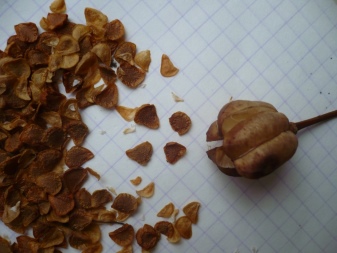
Diseases and pests
Asian varieties of lilies are characterized not only by easy care, frost resistance, but also high resistance to diseases and pests. Despite this, plants are sometimes susceptible to fungal infections. The most common diseases of these lilies include a number of ailments.
- Fusarium. It is manifested by the process of decay on the lower part of the bulb. If you notice this out of time, then it will be almost impossible to save the flower. In order to prevent damage to other bushes, a diseased plant is dug up from the site and destroyed, and healthy plants are treated with special solutions for preventive purposes.
- Botrytis. This is an infectious disease that infects the lily foliage, after which it becomes covered with brown spots and dries. Later, the infection spreads from the foliage to the buds of the plant. For the treatment of lilies, it is necessary to remove the affected areas, and treat the bush with a solution of "Fundazol".
- Rust. This is the most dangerous disease in which specks appear on the leaves, which later turn into rust. If the affected leaves are not removed in a timely manner, then the infection can spread throughout the flower bed.

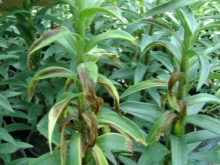

As for pests, the Asiatic lily is most often susceptible to insects such as onion fly, lily rattler and aphids. To combat these "unwanted guests", it is recommended to carry out preventive spraying using drugs such as "Aktara" and "Inta-Vir".
Lilies are much less likely to be attacked by bears, beetles and wireworms; they are destroyed with Medvetox.



Examples in landscape design
Asiatic lily is rightfully considered the queen of garden flowers, as it has extraordinary beauty, exquisite shapes and colors. It is often used in landscape design in summer cottages. However, many gardeners do not take into account the fact that this beauty is capricious, and not all "neighbors" are suitable for her. Therefore, when forming flower beds, you should not supplement these bright flowers with nondescript monochromatic plantings. Mixing several colorful tones is a great option. To do this, 4-6 lily bushes are planted in a mixborder, supplementing them with herbaceous perennial plants.
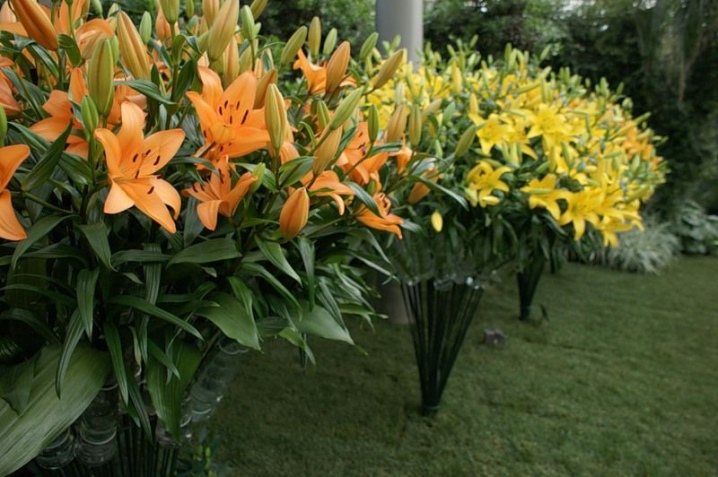
If you combine Asian lilies with other decorative flowers, it is important to correctly select their flowering period, growth, growing characteristics and a palette of shades. For example, lilies and peonies are ideally combined. Fragrant, bright and massive peony flowers will help to favorably emphasize the grace of lilies, and after flowering, the peony will be able to shade delicate beauties with its foliage. Such color combinations can be planted both in flower beds near houses, gazebos, and in gardens.
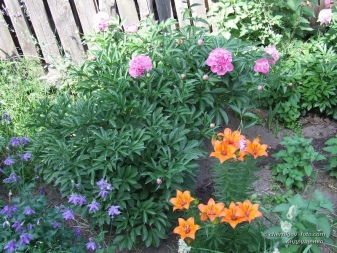
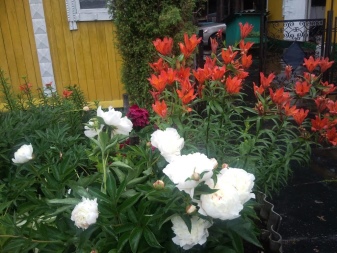
They look good on areas of lilies with irises, but it is difficult to grow these two flowers in the same area at the same time, since the former love watering, and the latter prefer moderate humidity. If you provide the plants with proper care, you can get a contrasting flower bed. Bright and fragrant lily flowers will elegantly complement the large iris leaves. Yellow lilies can also be planted in Mahonia beds - an unusual mix will give the landscape design a stylish look.
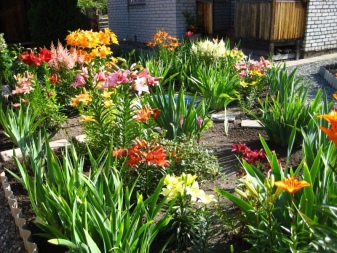
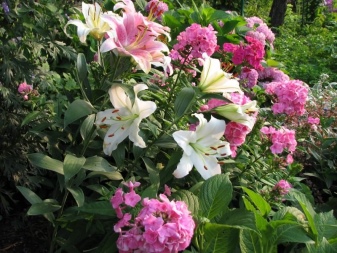
For more information on the Asiatic lily, see the next video.







































































































The comment was sent successfully.